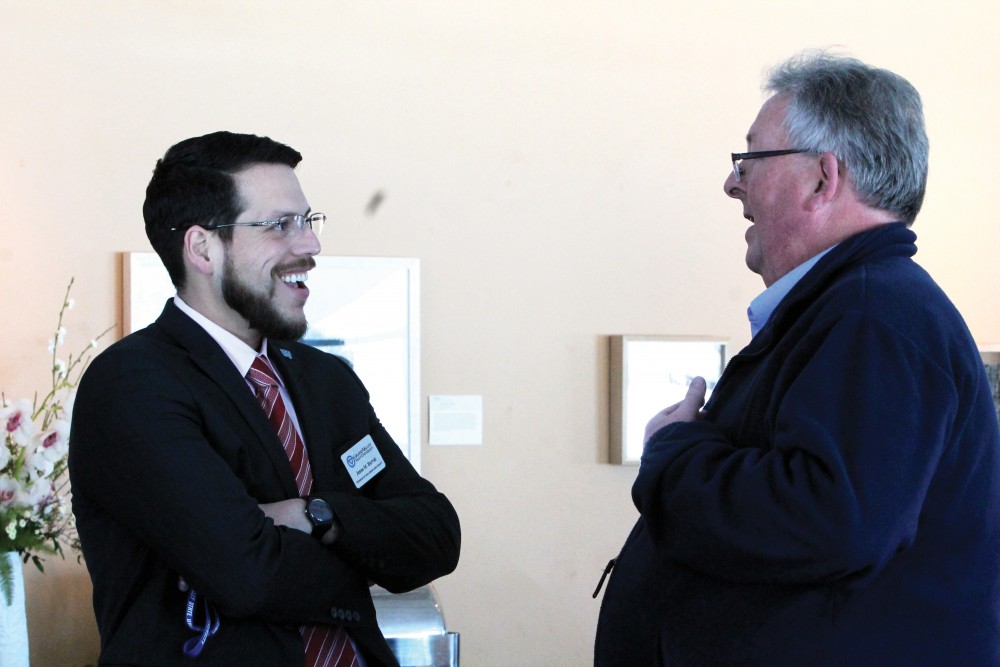Mapping Campus Climate

GVL / Emily Frye Vice President Jesse M. Bernal and Bob Stoll
Nov 9, 2015
Students at Grand Valley State University know that as soon as they step on campus, being a “Laker for a Lifetime” becomes a part of their identity. For some Lakers, identity can play a bigger role in their college experience than others. This is particularly true for those who identify as part of a minority population.
In order to get a reading on how students, faculty and staff of all identities experience being a Laker, the Division of Inclusion and Equity is launching its fifth Campus Climate survey this Thursday. It has been four years since the last survey was taken.
In 2011, Grand Valley State University conducted its fourth Campus Climate survey. The survey asked questions about how members of the GVSU community perceived the campus atmosphere and evaluated Lakers’ experiences on campus. Some of the results of this and other previous Campus Climate surveys are the creation of the Women’s Center, the Milton E. Ford LGBT Resource Center and the Office of Multicultural Affairs. The Bias Incident Report protocol and the formation of eight employee affinity groups are also results of data collected from Campus Climate surveys.
Since 2011, quite a lot has changed at GVSU. As such, the Division of Inclusion and Equity has created a new Campus Climate survey to reassess how individuals interact with GVSU. The survey opens on Nov. 12, and can be taken by all GVSU students, faculty and staff.
“This is a campus that actually uses the data when we get it,” said Jesse Bernal, vice president of the Division of Inclusion and Equity. “I’ve been at an institution before that collected a lot of data and had some fancy report and that was it, there was no action.
It’s pretty impressive to see all the places where the data is actually influencing day-to-day operations and long-term strategies (at GVSU).”
Overall, the previous Campus Climate surveys have shown positive reception to GVSU’s campus.
“What we knew from the 2011 survey in particular, is that all of our community members experience this campus overwhelmingly positively, in terms of experiences as well as perceptions of the environment,” Bernal said. “If you look at the national data, people at GVSU have a more positive experience than the national average.”
However, the 2011 data also showed that members of the LGBT community and people of color experienced GVSU’s campus less positively than the general population.
“It would be nice to see some of those inequities and disparities decrease, particularly over the last four years,” Bernal said. “It will be good to get community input on how we prioritize all the work that needs to continue to happen.”
In 2011, only 29 percent of the GVSU community completed the Campus Climate survey. While that is technically statistically significant, Bernal and his team hope for a higher completion rate this time around. Undergraduate students had a 26 percent completion rate, and graduate students had a 25 percent completion rate.
“That is quite a bit lower than faculty and staff,” said Andrew Plague, projects assistant for the Division of Inclusion and Equity.
“Ultimately, having everyone respond to the survey is the best outcome that we can hope for,” Bernal said. “Around 30 percent is the minimum threshold to do good data analysis. As close to 100 percent as we can get will give us the best chance of implementing actual things that are going to create change and get a really meaningful picture of the climate that exists here.”
According to Bernal, getting members of the Laker community to complete the survey is also the hardest challenge. This year, Bernal and his staff have made significant changes to the survey in the hopes of increasing the response rates.
In 2011, the survey took an average of 60 to 75 minutes to complete, and had to be completed in one sitting. This year, the survey will take 12 to 15 minutes.
“We’re only asking high-priority questions,” Bernal said. “We’re trying to be intentional about what we’re asking folks.”
In addition to shaving off nearly an hour from the survey, there are multiple rewards and incentives for students, faculty and staff that complete the survey. Up for grabs are four $2,000 tuition grants for students, three $1,000 research grants for faculty and three more $1,000 grants for staff. Depending on the completion rate, more rewards may become available.
“If faculty and staff respond at a combined response rate of 60 percent or higher, there will be additional student grants,” Plague said. “For students, everybody needs to be told about six times before they internalize the message. We’re hoping to make a huge leap in the student response rate. That tuition grant doesn’t hurt, either.”
Students are encouraged to attend the Campus Climate survey launch party the evening of Nov. 12 and complete the survey on the main floor of the Kirkhof Center in order to participate in a raffle for campus dining gift cards.
According to Bernal, GVSU community members will begin to see changes from this year’s survey as soon as the winter 2016 semester.
The Campus Climate survey will be available from Nov. 12 to Nov. 22, and may be accessed from a link sent to GVSU email accounts. For more information about the Campus Climate survey, visit www.gvsu.edu/mygvsu.






















